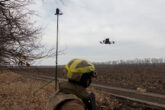April 17, 2018
Operational-Level Strikes Finally Enforce Obama’s Red Line
By all accounts, Friday night’s strikes against the Assad regime’s chemical-weapons facilities were successful — they reduced their targets to rubble, and there were no reported threats to allied forces or equipment in their aftermath. Armchair strategists are quick to point out that the strikes didn’t fit into any broader American Syria strategy. But the chemical-weapons attack of April 7 demonstrated, once again, the Syrian regime’s flagrant disregard for international moral and legal norms. And unlike last April’s retaliatory American strike on aircraft used for chemical-weapons delivery at Shayrat Air Base, Friday’s strikes sought to hit the heart of the regime’s chemical-weapons capabilities, and were coordinated with our oldest and closest allies.
They also marked a departure from Obama-era analysis paralysis in Syria. It was the Obama administration that delayed striking Assad and preventing future chemical-weapons attacks almost five years ago. It was the Obama administration that argued chlorine gas was a violation of the Chemical Weapons Convention in 2014, though it was widely known to be used on the Syrian battlefield throughout Obama’s time in office. It was the Obama administration that was caught by strategic surprise when the leadership vacuum left by the United States led the Russians to enter the Syrian fray in the fall of 2015, bringing with them high-tech military equipment for battlefield testing and deployability and bolstering their standing on the world stage. It was the Obama administration that argued a false choice between catastrophic nuclear war and limited strikes on targeted regime elements.
Read the full article at National Review
More from CNAS
-
Defense / Transatlantic Security
When Defense Becomes Destruction: Austria-Hungary’s Mistake and Ukraine’s RiskThis article was originally posted on War on the Rocks. The southeastern Polish city of Przemyśl, with its elegant 19th century Habsburg-era train station, remains one of the ...
By Franz-Stefan Gady
-
Defense / Transatlantic Security
Ukraine’s Catch-22 MomentThis article was originally published in the Financial Times. In Joseph Heller’s wartime classic, Catch-22, the protagonist Yossarian seeks out the US army surgeon Doc Daneeka...
By Franz-Stefan Gady
-
CNAS Insights | Budgetary Own Goals Undermine “Speed and Volume”
On November 7, Secretary of Defense Pete Hegseth laid out a plan to overhaul the Department of Defense’s (DOD’s) acquisition system. Placing an emphasis on delivering new capa...
By Philip Sheers, Carlton Haelig & Stacie Pettyjohn
-
Drones: Who Is Making the New Weapons of War?
From Ukraine and Russia to Gaza and Sudan, drones have become a key weapon of war. Which companies are making them, and profiting from this rapidly expanding but controversial...
By Stacie Pettyjohn




